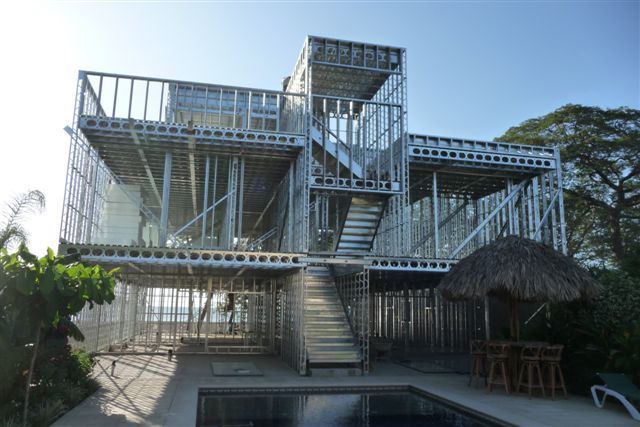Sustainable Benefits of Using Cold-Formed Steel Framing

There are many reasons why steel framing has come to the forefront as one of the best and most feasible alternative building materials for residential and commercial construction. Steel framing is easy to handle on-site. It is light in weight because steel has the highest strength-to-weight ratio of any construction material, resulting in the use of less framing material compared to wood for an equal size structure. An average 2,000 square foot steel framed house can generate as little as a cubic yard of recyclable scrap. While many construction sites may have large amounts of construction and demolition waste to dispose, using steel will minimize that problem as it can be easily recycled responsibly.
General Benefits
- Most cost-effective mid-rise structural material
- Shorter and predictable construction schedule
- Highest strength-to-weight ratio of any building material
- 100 percent recyclable
- 68 percent industry recycling rate
- Non-combustible - does not burn nor contribute fuel to the spread of a fire
- Inorganic - will not rot, warp, split, crack or creep
- Dimensionally stable - does not expand or contract with moisture content
- Consistent material quality - produced in strict accordance with national standards, no regional variations
Benefits to the Builder
- Substantial discounts on builders risk insurance
- Lighter than other framing materials
- Non-combustible
- Easy material selection - no need to cull or sort the pile and small punch list
- Saves job-site time with ease of panelization off-site
- Straight walls and square corners
- Windows and doors open and close as they should
- Less scrap and waste (2 percent for steel vs. 20 percent for lumber)
- Price stability - price spikes are extremely rare
- Consumer perceives steel as better
Benefits to the Consumer
- High strength results in safer structures, less maintenance and slower aging of structure
- Fire safety - doesn't burn or add fuel to the spread of a house fire
- Not vulnerable to termites.
- Not vulnerable to any type of fungi or organism, including mold
- Less probability of foundation problems - less weight results in less movement
- Less probability of damage in an earthquake
- Lighter structure with stronger connections results in less seismic force
- Less probability of damage in high winds
- Stronger connections, screwed versus nailed
All steel products, including steel framing and steel roofing, contain recycled steel. Steel framing contains at least minimum of 25 percent recycled steel and is continually and completely recyclable. Using recycled steel takes the pressure off renewable resources: if built with wood, that same 2000-square-foot home would require about 40 to 50 trees. With steel, only the equivalent of about six scrapped automobiles is needed for the same size home. In contrast to many other building materials, steel is routinely collected in aggregate quantities from construction and demolition sites and recycled into new steel products. Often times the money brought back into a project from selling the recyclable scrap steel can offset many project expenses.
At the end of a steel-framed home’s product life the steel components would also be recyclable. Framing with steel as a material consumes only 6.25 percent of the total life cycle energy used by a home; the balance is consumed by heating and cooling, food refrigeration and lighting. Thermal barrier insulating materials provide exceptional heat and cooling loss protection to steel-built homes. Additionally, steel framing results in less air loss around windows and doors as well as foundation and roofing connections.
Visit the Steel Recycling Institute's new website to learn even more about the sustainability of steel products.